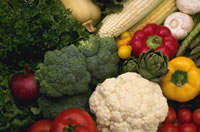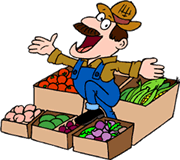|
Other than the occasional masher in the potato section or that out-of-control 5-year-old playing Indy 500 with a shopping cart, buying food at the local supermarket seems convenient and a good deal. But is it? If you like getting the freshest
 food possible, if you have more kinship with family farmers who care about the food they grow than with corporations that focus on bottom lines, if you think growing food shouldn't require that we accept air and water pollution, then you may want to rethink your trips to the nearest Shoppers Mega-Food Depot.
food possible, if you have more kinship with family farmers who care about the food they grow than with corporations that focus on bottom lines, if you think growing food shouldn't require that we accept air and water pollution, then you may want to rethink your trips to the nearest Shoppers Mega-Food Depot.
Today's Eco-Logical is adapted from materials provided by LocalHarvest.org, which promotes "buying local" and maintains a database of small farms, farmers markets, and other local food sources to help people in the United States find sources of locally grown food in their area.
The richness, variety, and flavor of our communities, food systems, and diets are in jeopardy. Factory farms, agribusiness control of the food system, and mega-supermarkets have brought us low prices and convenience but have taken away many other essential aspects of our "food lives," such as a personal relationship with food and with the people who produce it. They have also diminished our understanding of the basic nature of food and farming. More and more people are realizing this and are actively working to turn the tide and to preserve a food industry based on family-owned, small-scale businesses. Local farmers and small entrepreneurs are our best guarantee against a world of Styrofoam-like, long-shelf-life tomatoes and diets dictated from corporate boardrooms.
Most produce in the US is picked 4 to 7 days before being placed on supermarket shelves and is shipped an average of 1,500 miles before being sold. And this only takes into account US-grown products! Those distances are substantially longer when we consider produce imported from Mexico, Asia, Canada, South America, and other places.
We can only afford to have such a long-distance food system now because of the artificially low energy prices that we currently enjoy. (Gas at the pump may not seem that cheap, but by historical standards, it is not particularly expensive.
 The oil industry and transportation industries in the US receive massive taxpayer subsidies every year.) Additionally, we have cheap food because we externalize the environmental costs of industrial farming, such as water pollution, air pollution, and burned-out soil.
The oil industry and transportation industries in the US receive massive taxpayer subsidies every year.) Additionally, we have cheap food because we externalize the environmental costs of industrial farming, such as water pollution, air pollution, and burned-out soil.
Subsidization of large-scale industrial agriculture with government price supports and taxpayer-funded cooperative-extension research generally benefits wealthy corporate farmers at the expense of small farmers. This ultimately hurts not only the small farmers but their communities as well. Concentrated farming operations and production-line food processing are also threatening the security of our food system, as demonstrated by outbreaks of diseases such as e-Coli or Mad Cow Disease, contamination of crops and seed stocks with genetically modified strains, and other food-related health scares that are often seen nowadays on the news.
Large-scale, agribusiness-oriented food systems are bound to fail in the long run, sunk by their own unsustainability. But why wait until we're forced by circumstance to abandon our destructive patterns of consumption? We can start now by buying locally grown food whenever possible. By doing so you'll be helping preserve the environment, and you'll be strengthening your community by investing your food dollars close to home. When you buy food at a large supermarket, only 18 cents of every dollar you spend goes to the grower—wherever he or she may be located—whereas 82 cents goes to various middlemen. You can save money, get fresher food, and support small farmers all at the same time by cutting out the middlemen and buying local.
So, how does one go about making the conversion from supermarket shopper to local-food buyer? LocalHarvest.org maintains a
 searchable nationwide directory of small farms, farmers markets, and other local food sources. The search engine helps people find local sources of sustainably grown food and helps them establish direct contact with family farms in their area.
searchable nationwide directory of small farms, farmers markets, and other local food sources. The search engine helps people find local sources of sustainably grown food and helps them establish direct contact with family farms in their area.
The Buy Local movement is quickly taking us beyond the promise of environmentally responsible farming that the organic movement delivered and is awakening the US to the importance of additional aspects of our food economy such as freshness, community, variety, humane treatment of farm animals, and social justice.
Here's how you can help (and eat healthier!):
- Read our article about getting locally grown food via CSAs
- Search for locally grown food at LocalHarvest.org
- Encourage your local farmers, market managers, or favorite restaurateurs to visit localharvest.org and sign themselves up
|
LocalHarvest.org was founded in 1998 by Guillermo Payet, a software engineer and activist dedicated to generating positive social change through the Internet. LocalHarvest is now the number one way that the public can get information about buying food from family farms.
|
|
More articles and resources on....
Get Grinning Planet free via email
|


